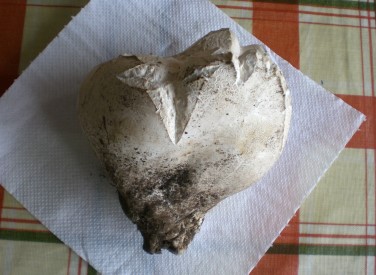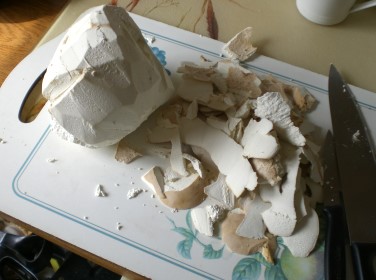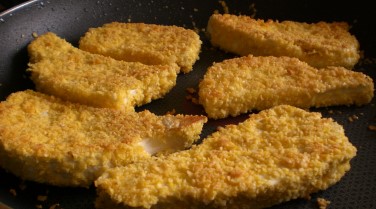Giant Puffball
By Mike on Saturday, September 4, 2010, 20:47 - Permalink
 In a grassy pasture at West Dean, Sussex, we found a giant puffball...
In a grassy pasture at West Dean, Sussex, we found a giant puffball...
Identification Of Wild Fungi
The description here is not intended to be sufficient for conclusive identification of these wild fungi - the reader should understand that the possible outcomes of misadventure with wild-gathered fungi include serious illness and death.IT IS YOUR OWN RESPONSIBILITY to take adequate steps in identifying any fungi you gather for the table - doubly so if you are intending to share them with someone else.
Informal descriptions, such as the one on this page, are not adequate for full identification - it's just good sense to fully and independently verify everything you read here.
Rules of thumb or folk wisdom identification methods are frequently unreliable.
Consult a comprehensive identification guide (I recommend Roger's Mushrooms (site no longer available - see here) and Wild Mushrooms Online) or best of all, talk to a living human expert mycologist.
What Are Giant Puffballs?
Langermannia gigantea - This wild fungus is found in grassland and pastures, particularly on chalky soil. It is broadly spherical in shape and may easily grow to 18 inches in diameter or more. (There are anecdotal reports of the fruiting bodies of this fungus being mistaken at a distance for sheep).

Damage from animals, insects or environmental factors may cause the fruiting body to grow into quite irregular, sculptural shapes.
The skin and flesh are pure white at first, changing through pale cream and yellow with age and ending up dark yellow-brown. This fungus is edible ss long as the flesh remains white - smaller specimens are best, having a firm spongy texture that squeaks when cut. The flesh of older ones may begin to be wooly as they get past 12 inches across.
 The one I found was perfect for the table - about 6 inches across and shaped lie an enormous tooth - a little scarred at the top, but still completely sound.
The one I found was perfect for the table - about 6 inches across and shaped lie an enormous tooth - a little scarred at the top, but still completely sound.
Unlike many other fungi, there are no gills to get filled with dirt and sand - so the puffballs need no special handling. They'll store for a day or two in an open container or on a plate in the refidgerator or other cool place.
 Preparation is simple -first brush off any loose dirt, using a damp sponge if necessary.
Preparation is simple -first brush off any loose dirt, using a damp sponge if necessary.
Then slice away the outer skin with a sharp knife - there's very little waste.
The flesh can then be sliced up - the texture is a bit like polystyrene foam at this stage, but it's quite crumbly, so I used a thin, sharp knife, supporting the whole thing so as not to break it up.
 I dipped the slices in egg, then dredged them in crumbs made from tortilla chips which I had previously smashed up in a bag.
I dipped the slices in egg, then dredged them in crumbs made from tortilla chips which I had previously smashed up in a bag.
If not breading the slices, they still need coating in egg or a light batter of some kind, otherwise they will soak up a great deal of fat when fried, and will not be pleasant to eat.
 I fried the slices for about 5 minutes on each side in a nonstick pan with just a little oil.
I fried the slices for about 5 minutes on each side in a nonstick pan with just a little oil.
Bacon fat can be used for the frying - and this will be nice, although obviously not suitable for vegetarians that way.
As they cook, they will soften and shrink a little, but do not tend to change a lot, or release much juice.
 I served them with potato wedges, baked beans and fried eggs. They would also be pretty good served with lettuce and mayonnaise in a bun, in the style of a chicken sandwich.
I served them with potato wedges, baked beans and fried eggs. They would also be pretty good served with lettuce and mayonnaise in a bun, in the style of a chicken sandwich.
The texture is pleasantly soft and light - the flavour is mild and mushroomy - all in all, it's a lot like eating the white part of shop-bought mushrooms - just big slabs of it.
Picking Giant Puffballs
Giant puffballs are possibly the easiest entry point for the first-time fungus forager - there really isn't anything else like them, so you'd have to be spectacularly inept to mistakenly gather anything else mistaking it for these.
